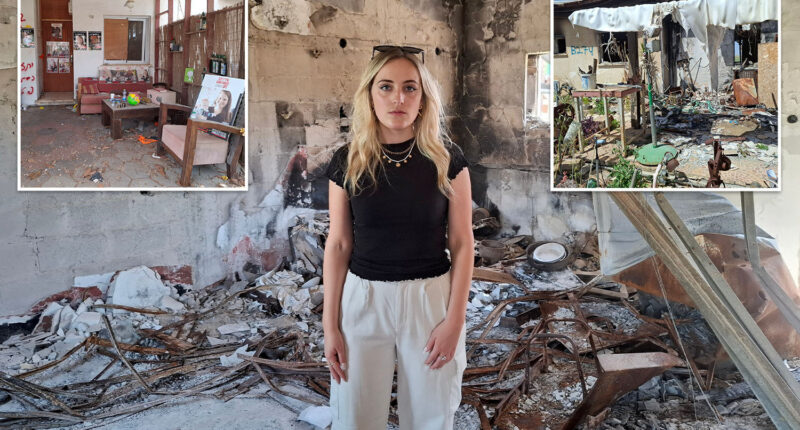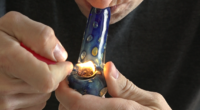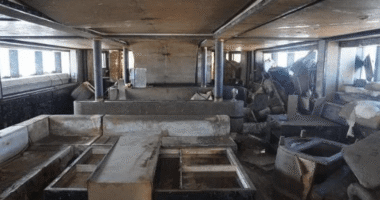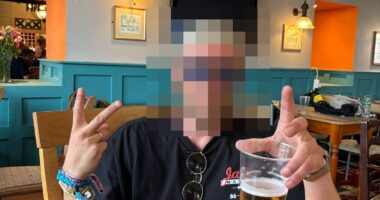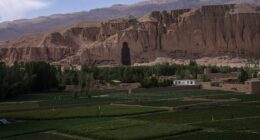WALKING across endless charred rubble and looking up at more bullet holes than I could count, my stomach turned.
For almost seven decades, kibbutz Nir Oz in southern Israel was a haven for its 400 residents.






But their paradise just a mile from the Gaza border was torn apart on October 7, 2023.
Many Hamas militants attacked the village, randomly killing and causing a wound that may never completely heal during one of Israel’s darkest days. It’s a tragic event that has left a scar on the community.
Early that morning, the kibbutz was attacked from three directions after Hamas fighters tore through Israel’s defences.
Spineless terrorists blew up security cameras, automated weapons systems and motion detectors before mowing down the fence.
As gunmen swept through the kibbutz, terrified families attempted to lock themselves in safety.
But ruthless gunman barbarically torched their homes to deliberately force them out.
Cowering families too petrified to face Hamas brutes were burned alive in their homes.
Some of those who came face to face with gunmen were executed on the spot while others were frogmarched over the border back to the terrorist’s lair.
More than a quarter of the kibbutz’s residents were either killed or taken hostage in one of the most vile atrocities on October 7.
Per capita, Nir Oz suffered the most bloodshed and damage.
More than a year and a half on, the kibbutz remains a heartbreaking memorial to the devastation and destruction Hamas inflicted.
Walking around this gut-wrenching crime scene is not for the faint-hearted.
Like many of us, I’ve seen countless photos and videos of the kibbutz – each one more sickening than the last.
But nothing could have prepared me for seeing the area that should be filled with life and instead bears the scars of inconceivable horror in person.
Aside from the occasional cry from a cat or the soft sound of wind chimes, the silence in the kibbutz is deafening.
Once a close-knit community where children grew up and adults grew old, every aspect of human life has been shattered.
Rows of modest, single-storey homes sit burnt-out in a harrowing reminder of Hamas’ callous actions.
It took the IDF several hours to reach the kibbutz on October 7, by which time all Hamas terrorists, and later looters, had left.
Ironically, the kibbutz, with its view towards Gaza, was established by peace activists striving to create a safe haven for those advocating for peace. The tragedy that unfolded goes against everything they stood for.
Idealists who believed it was possible to live in peace came to live in the village, hoping to overcome centuries of entrenched hate.
Among the founders was Oded Lifshitz, who lived in Nir Oz for almost 70 years with his wife.







Both were brutally kidnapped by Hamas on October 7, and while Yocheved was released weeks later, Oded was killed while captive in Gaza.
Journalist Oded, 83, died in Hamas’ clutches despite campaigning for the recognition of Palestinian rights and peace between Arabs and Jews.
Oded’s is a story I have followed from the start, keeping in touch with his grandson Daniel as the family desperately awaited any news.
After Oded’s body was callously returned in a locked coffin, Daniel told me not enough was done to save his grandfather.
Daniel’s mum Rita, Oded’s daughter-in-law, choked back tears as she showed me his home.
She pointed to an empty beer can discarded among the rubble and told how they would enjoy a cold can together before.
As I stepped inside, my blood ran cold at the sight of Oded’s burnt-out piano that he once used to entertain his beloved family.
Rita showed me a video of peace activist Oded playing beautifully as his loved ones relaxed and listened.






Feeling a surge of anger, I struggled to comprehend how Hamas could take away such a precious life and the lives of many others in such a brutal manner. It was a senseless act of violence that left a deep mark on everyone affected.
The safe room Oded and his wife of 63 years were dragged from had been totally decimated.
Looking at the bullet-riddled walls and blackened debris, I tried to imagine the sheer terror Oded and Yocheved felt as they were found by vile Hamas gunman.
Outside, the stunning cactus garden the couple spent years nurturing has started to come back to life thanks to kind-hearted volunteers.
But the lush greenery is not enough to mask the death and destruction here.
Walking across burnt debris and shards of glass is enough to make even the toughest sick – especially as bloodstains on walls and floors remain.
Further into the kibbutz I came to the Bibas home and it was hard to hold back tears.
Toys never to be played with again are strewn outside the home Shiri and her two beautiful sons Kfir and Ariel were snatched from.
What happened to the Bibas family?

HAMAS terrorists kidnapped the Bibas family from their home in Nir Oz during the horror October 7 assault.
Yarden Bibas was abducted separately from his wife Shiri and son Ariel, four, and nine-month-old Kfir.
They were hauled to Gaza where they were held hostage.
Shiri’s parents were both killed in the attack on the kibbutz.
Shiri and her boys – the two youngest hostages taken from Israel on October 7 – became symbols of the hostage crisis.
Late in 2023, Hamas claimed the mum and youngsters were killed in an Israeli airstrike without offering any proof.
Israeli authorities were unable to confirm their deaths.
Fears for Shiri, Ariel and Kfir grew as the months went by amid a lack of confirmation whether they were still alive or not.
On February 1, Yarden was released amid the ceasefire after 484 days in captivity.
Then on February 20, Hamas handed over coffins it said contained the bodies of Shiri, Ariel and Kfir.
Ariel and Kfir’s remains were verified by Israel, but the remains of the female did not match Shiri’s DNA.
Her body was finally handed back on the evening of February 21.
Hundreds lined the streets for their funerals on February 26, with buildings and monuments around the world illuminated in orange as a tribute to the boys’ hair colour.
Shiri, Ariel and Kfir were buried alongside her parents in Tsoher Regional Cemetery.
Shiri’s petrified face as she clung to her two precious, red-headed boys will long be etched into the minds of millions the world over.
Pictures of Shiri, Kfir, Ariel and dad Yarden – who was released in November – are perched on a sofa the family would once have sat on together.
Ariel was just four years old and baby brother Kfir just nine months when they were taken hostage and robbed of a childhood by Hamas.
Their bodies were released in a vile ceremony by Hamas alongside Oded’s in February.
Hamas entered all but six of the more than 200 homes in this peaceful kibbutz, and even their dining hall wasn’t spared the terror group’s wrath with bullet holes in the entrance now greeting visitors.
Inside, empty dining tables have been laid up and the community’s postboxes hold letters that will likely never be retrieved.
Kibbutz Nir Oz has become a symbol of peace and resilience in the face of adversity and efforts are being made to rehabilitate the neighbourhood.
More than £70million from the state will be invested into redeveloping the community, whose residents are living in temporary housing more than an hour’s drive away in Kiryat Gat.
Some 13 hostages kidnapped from Nir Oz remain trapped in Gaza. Heartbreaking, not all of them are alive.
In a testament to their strength, residents of the kibbutz continue to battle every day for their release hoping one day they will dine again together.







